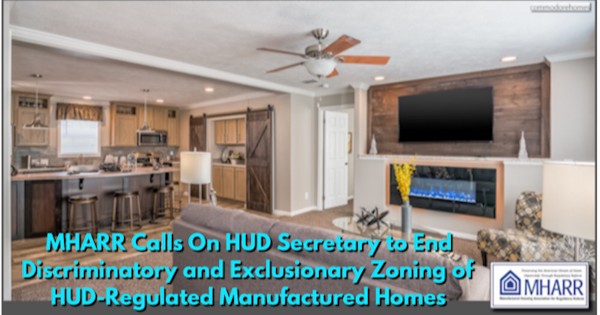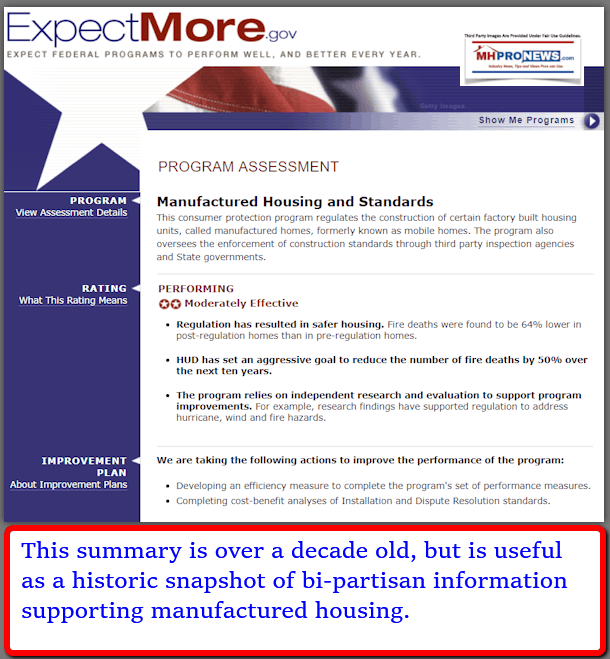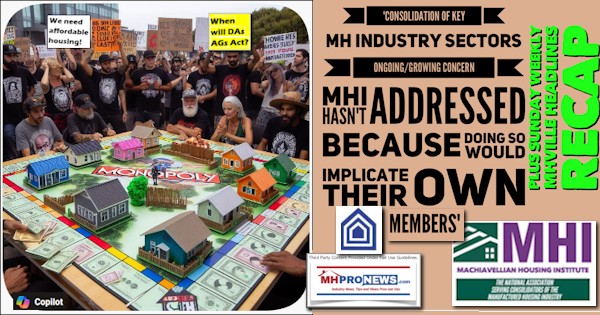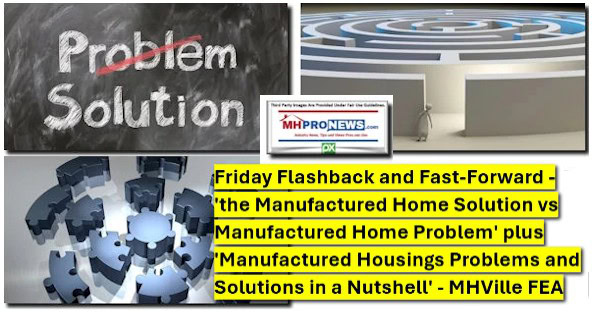
There is an affordable housing crisis, as HUD Secretary Ben Carson has been stressing for some time.
To fully grasp the value of a bipartisan approach to addressing what has arguably been going wrong with the most proven form of affordable housing in America – manufactured homes – it is relevant to look back. Snapshots and details from prior handling of manufactured homes paint a picture that professionals, advocates, legislators, and others can consider.
During the Obama Administration, there is a federal archive, dubbed: obamawhitehouse.archives.gov.
From that, the following information has been harvested from the “ExpectMore.gov” pages.
In section 1.3 of the information quoted at length, below, is this: “The [Manufactured Housing Improvement] Act provides that the Federal construction and safety standards for manufactured homes pre-empt all state and local building codes. Therefore, no other Federal, state or local program has any authority in this area.”
That may bear repeating. So let’s do so.
“The [Manufactured Housing Improvement] Act provides that the Federal construction and safety standards for manufactured homes pre-empt all state and local building codes. Therefore, no other Federal, state or local program has any authority in this area.”
In that context, consider what the Manufactured Housing Association for Regulatory Reform (MHARR) published in their recent letter to HUD Secretary Carson, found as a download from the link below.

But there is much more in this assessment from the Obama Archive that merits consideration. Numbers of concerns that the public at large has held for years are debunked by the federal findings published below.
One of the topics addressed is resale values. The FHFA and the National Association of Realtors both published research in 2018 that reflect the appreciation of manufactured homes. Note too that this appreciation is occurring despite the lack of a full and proper implementation of the Duty to Serve Manufactured Housing.
The report that follows is summed up as follows, per that same source.

Having set the table, let’s dive into Obama Administration archive era federal report.
Questions/Answers (Detailed Assessment)
| Section 1 – Program Purpose & Design | |||
| Number | Question | Answer | Score |
| 1.1 | Is the program purpose clear?
Explanation: Yes. By establishing and enforcing uniform Federal construction and safety standards, the program’s purpose is to protect the residents of manufactured homes from personal injury, property damage and insurance costs; to advance the quality, durability, safety and affordability of manufactured homes; and to facilitate the availability of affordable manufactured homes and increase homeownership for all Americans. Evidence: The purposes of program are set forth in the National Manufactured Housing Construction and Safety Standards Act of 1974 as Amended by the Manufactured Housing Improvement Act of 2000 (The Act). |
YES | 20% |
| 1.2 | Does the program address a specific and existing problem, interest, or need?
Explanation: Prior to the Act, manufactured housing historically had lacked the quality, durability and safety of site-built homes. With the enforcement of uniform Federal safety and construction standards, the quality and safety of manufactured homes has significantly improved. Standardized oversight and inspection of design and construction has also reduced the cost and administration to manufacturers that have a common set of standards. Evidence: Committee hearing testimony from 1974 documented the numerous safety and quality problems with pre-HUD code homes. Studies by the National Fire Protection Association and HUD showing that civilian fire deaths in HUD units built from 1980 to 1996 were 64% lower than for pre-HUD units. Similar reductions for injuries and property damage were also found. HUD standards also reduced complaints of formaldehyde exposure from 1500 to nearly zero in 1984. Newly published HUD report on Hurricane Charley documenting improved performance of manufactured homes built to the wind standards published in 1994 following Hurricane Andrew. |
YES | 20% |
| 1.3 | Is the program designed so that it is not redundant or duplicative of any other Federal, state, local or private effort?
Explanation: The Act provides that the Federal construction and safety standards for manufactured homes pre-empt all state and local building codes. Therefore, no other Federal, state or local program has any authority in this area. The Act also provides that individual states may apply to participate in the enforcement of the program as State Administrative Agencies (SAAs). Evidence: The preemptive nature of the Act and the regulations requiring HUD approval before a state may participate in the enforcement of the Act. |
YES | 20% |
| 1.4 | Is the program design free of major flaws that would limit the program’s effectiveness or efficiency?
Explanation: The program allows HUD to establish national standards for the construction and safety of manufactured homes, and further allows HUD to act in multiple ways to enforce those standards. HUD can receive information indicating that a serious defect or imminent safety hazard may exist in a class of manufactured homes from the monitoring contractor, an SAA or through a consumer complaint. HUD can then act by investigating the information and issuing a preliminary determination, as can its 38 state SAA partners. In the 12 states without an SAA, only HUD may take such action. A potential flaw in the design of the program is the difficulty ensuring that the In Plant Inspection Agents (IPIAs) who are employed by the production plants remain sufficiently independent and report all violations. Evidence: No recommendations to fundamentally restructure the program have been made during its 29-year existence; however, the Manufactured Housing Improvement Act of 2000 gave HUD additional authority to design installation standards and a dispute resolution program. |
YES | 20% |
| 1.5 | Is the program design effectively targeted so that resources will address the program’s purpose directly and will reach intended beneficiaries?
Explanation: The program has the ability to target program activities and resources to the agencies and program partners demonstrating the greatest problems. For example, a manufacturer and its in-plant primary inspection agency (IPIA) that demonstrates a higher than average number of failures to conform after a HUD-sponsored audit, or an increased number of failures to conform would be subject to “follow-up” audits. ” As part of these audits, an IPIA operating in a plant, receives a second or third auditing visit from the Department’s contractor to ensure the IPIA and the manufacturer have put in place the necessary correction noted in the Department’s first audit. Evidence: The monthly report provided by the program’s monitoring contractor lists every follow-up and post-production follow-up audit conducted during the previous month. In 2004, there were XX follow-up audits representing approximately xx% of the HUD’s audit resources. |
YES | 20% |
| Section 1 – Program Purpose & Design | Score | 100% | |
| Section 2 – Strategic Planning | |||
| Number | Question | Answer | Score |
| 2.1 | Does the program have a limited number of specific long-term performance measures that focus on outcomes and meaningfully reflect the purpose of the program?
Explanation: The program has two long-term performance measures reflecting the statutory mandates. For protection of consumers and ensuring the safety of manufactured houses, HUD will measure (and aim to reduce) the number of fire deaths in manufactured homes. In addition, to measure the quality of manufactured housing, HUD will measure the re-sale value of manufactured homes. Another long-term measure HUD has adopted is ensuring new Installation and Dispute Resolution programs are adopted. Evidence: The number of fire deaths is an excellent outcome measure that tells an important story about the safety of manufactured homes. In addition, it can serve as a proxy for how well other standards are being met. Trends in the re-sale value of homes will also provide some indication of the quality and durability of the homes although other factors may influence this number as well. |
YES | 11% |
| 2.2 | Does the program have ambitious targets and timeframes for its long-term measures?
Explanation: Fire death and re-sale value data will be collected every 5-10 years, and ambitious targets have been set for both. For ensuring establishment of the two new programs, the target is to ensure the provision of installation and dispute resolution services by certified firms and individuals in HUD-administered states by 2008. Evidence: HUD plans to work with the National Fire Protection Association (www.nfpa.org) to get data every 10 years on the number of fire deaths. HUD aims to reduce the number of fire deaths by 50 percent over next 10 years. Re-sale value of manufactured homes will be collected from industry data. |
YES | 11% |
| 2.3 | Does the program have a limited number of specific annual performance measures that can demonstrate progress toward achieving the program’s long-term goals?
Explanation: HUD’s annual measures support the program’s long-term goals is to assist the Department in reaching its Strategic Goal to Embrace High Standards of Ethics, Management and Accountability to Ensure Program Compliance by enhancing monitoring and enforcement. HUD is working to develop efficiency measures for their program. They must work to identify administrative costs needed to perform follow-up audits, correct homes, or pursue enforcement cases. Evidence: Three annual measures are or will be reported: 1. The annual performance measure for protecting consumers is the number of investigations and enforcement cases pursued each year. 2. HUD also measures the number of homes corrected as a result of federal investigations and enforcement actions. 3. HUD recently decided to count the number of plants requiring follow-up audits to measure how well its inspection processes work. |
YES | 11% |
| 2.4 | Does the program have baselines and ambitious targets for its annual measures?
Explanation: HUD sets ambitious targets for each of its three annual measures. They aim to improve performance between 5 and 10 percent each year for each measure. Evidence: HUD aims to increase the number of enforcement cases and homes corrected as a result of those cases by at least ten percent each year from the baseline of 34 enforcement cases in 2003. The baselines for number of homes corrected and number of plants requiring audits are still being developed. |
YES | 11% |
| 2.5 | Do all partners (including grantees, sub-grantees, contractors, cost-sharing partners, and other government partners) commit to and work toward the annual and/or long-term goals of the program?
Explanation: In protecting consumers through investigations and enforcement, the program relies on a variety of cooperating parties. Many of the Department’s investigations and enforcement actions stem from the initial investigations undertaken by the 38 state administrative agencies who have cooperative agreements with the federal program, the 17 in-plant primary inspection agencies (IPIAs), and 7 design approval primary inspection agencies (DAPIAs). States and their appointed agencies have worked with HUD program staff to ensure that states develop installation and dispute resolution program regulations to allow the maximum number of states to administer their own programs. HUD will continue to work with stakeholders on new measures adopted. Evidence: The Department also works in cooperation with the other federal agencies to identify potential non-compliance, and in initiating investigations and enforcement by the Department. HUD also partners with the National Fire Protection Association. To ensure establishment of the two new programs in all states, federal program staff have worked with the following states in the state efforts to put in place the necessary elements to administer state installation and/or dispute resolution programs by January 2006: DE, GA, ID, IA, IN, KS, LA, NY, OH, OK, PA, TN, WA, and WI. HUD has also shared information with the two national industry groups, the 0Manufactured Housing Institute (MHI) and the Manufactured Housing Association for Regulatory Reform (MHARR), assisting them in their efforts to encourage and assist states to establish state-based manufactured housing installation and dispute resolution programs. |
YES | 11% |
| 2.6 | Are independent evaluations of sufficient scope and quality conducted on a regular basis or as needed to support program improvements and evaluate effectiveness and relevance to the problem, interest, or need?
Explanation: Prior to undertaking most construction and safety standards revisions of a substantial nature, the Department undertakes independent research to support the program improvements. The program has relied on a variety of independent evaluations to support program improvements and evaluate effectiveness and relevance to the program area. However, most evaluations to date have focused on specific aspects of safety standards rather than the program as a whole. HUD next plans to work with PD&R to develop a comprehensive study that examines the entire program offices’ effectiveness. Evidence: Examples of recent research include a March 2005 report from the Institute for Building Technology and Safety entitled “An Assessment of Damage to Manufactured Homes Caused by Hurricane Charley.” Fire research also supported the Smoke Alarm Rule in 2002, the final rule for formaldehyde emissions published in 1984, the upgraded wind requirements in the final rule published in 1994, and the upgraded energy requirements final rule published in 1993. Independent evaluation of fire losses in manufactured homes identified trends supporting the actions taken in the final rule. In 1998-1999 the Department commissioned the National Institute of Standards and Technology to evaluate the adequacy and reliability of the current requirements for smoke alarms, which had been in the federal manufactured home construction and safety standards since 1976. |
YES | 11% |
| 2.7 | Are Budget requests explicitly tied to accomplishment of the annual and long-term performance goals, and are the resource needs presented in a complete and transparent manner in the program’s budget?
Explanation: The level of appropriations is key to the Department’s oversight and auditing of the design approval primary inspection agencies. With reduced appropriation, the federal manufactured housing program would reduce its oversight of these three groups, providing increased opportunity for poor performance by manufacturers, and an increased number of failures to conform in completed homes. Evidence: The Office of Manufactured Housing Programs outlines its budget justifications as required by OMB, with a Performance Measurement Table and the Performance Indicator outlined in the Annual Performance Plan. Appropriated funds are provided in that format. The 2005 Congressional Justification is provided as required by the Department. In the FY 2005 justification, the cost categories totaled the requested amount for the appropriation of $13 million and are broken out into the following categories: Payments to states; Salaries; Contract for monitoring primary inspection agencies and states; Contract for consensus committee administering organization; Other contracts; Contract for installation inspection and enforcement; and Contract for dispute resolution enforcement. |
YES | 11% |
| 2.8 | Has the program taken meaningful steps to correct its strategic planning deficiencies?
Explanation: The Office of Manufactured Housing and Standards conducts annual, monthly, and weekly meetings that identify deficiencies and ensure achievement of long-term goals. Evidence: The Office of Manufactured Housing and Standards conducts an annual strategic planning meeting, followed by monthly meetings with staff and the contractor responsible for sustaining compliance of homes to the construction and safety standards; monthly meetings with staff and the Administering Organization contractor responsible for maximizing cooperation with the MHCC; weekly meetings with the FHA Commissioner on FHA matters; and planned monthly meetings with staff and the contractor responsible for overseeing the federal installation program in 2006. |
YES | 11% |
| 2.RG1 | Are all regulations issued by the program/agency necessary to meet the stated goals of the program, and do all regulations clearly indicate how the rules contribute to achievement of the goals?
Explanation: All regulations currently being drafted and published as proposed rules are tied to goals established by the 2000 Act, in addition to the statutory goal of establishing the installation and dispute resolution programs. Evidence: The first proposed rule necessary to establish one of the two mandated programs was published on April 26, 2005. The other proposed rules include a draft proposed rule to establish the Installation Program and the Dispute Resolution Program. Another proposed rule for which the public comment period has ended and the Department is preparing a final rule, is a proposed rule to revise the federal construction and safety standards. In addition to those mandated by statute, there are regulatory actions proposed by the MHCC which the program office is required by statute to act. These include a rule to define and allow on-site completion of manufactured homes. Other regulatory actions include a proposed rule to correct inequities created in a regulation revising the payment of fees to states, and a rule in draft to increase the fee amount from $39. |
YES | 11% |
| Section 2 – Strategic Planning | Score | 100% | |
| Section 3 – Program Management | |||
| Number | Question | Answer | Score |
| 3.1 | Does the agency regularly collect timely and credible performance information, including information from key program partners, and use it to manage the program and improve performance?
Explanation: The agency collects performance information and uses it to improve performance. The program office relies on staff and contractor oversight of the performance of the in-plant primary inspection agencies (IPIAs), design approval primary inspection agencies (DAPIAs), and state administrative agencies (SAAs) through annual performance reviews. Inspectors spend approximately 300 days each year in manufacturing plants overseeing the monitoring work of the IPIAs, receiving for record and random review 18,000 design pages of manufactured homes, and undertaking 22 reviews of state administrative agency performance. They submit checklist assessments to HUD annually. Based on this information, the program office identifies program weaknesses and requires increased HUD monitoring, or plans of corrective action. Information on follow-up audits and homes completed is also gathered from these actors. Evidence: Based on audits or visits to plants, the program office may shift resources to increasing monitoring of poorly performing partners. IPIAs may receive follow-up audits, DAPIAs may receive increased monitoring, and SAAs may receive on-site visits. The program’s contractor has collected this information for over 20 years, providing valuable baseline information for the performance of program partners. For example, an increased number of audit findings in plants in Florida (in which the State of Florida serves as the IPIA) caused the federal program to order a higher than usual number of follow-up audits on the Florida production lines. This combined with a static number of failures to conform during the follow-up audits keyed the federal program to target technical assistance and intervene early. |
YES | 9% |
| 3.2 | Are Federal managers and program partners (including grantees, sub-grantees, contractors, cost-sharing partners, and other government partners) held accountable for cost, schedule and performance results?
Explanation: The program managers and partners are accountable for achieving performance goals. The Manufactured Housing Program Administrator reports to the Assistant Secretary for Housing and the Secretary, and in the Office of General Counsel, the Assistant General Counsel for the Division of Compliance. For program partners, the performance of IPIAs, DAPIAs and SAAs are reviewed annually, based on regular audits throughout the year. Evidence: All state administrative agencies (SAAs) and primary inspection agencies (PIAs) are held accountable for cost, schedule and performance results through oversight of their own work within manufacturing plants throughout the year, which is summarized in an annual review of performance. These third parties are paid directly from the manufacturers, with their costs, schedules, and performance controlled by market forces for the private PIAs, and by state regulation for the state PIAs. The work of the program contractor, conducting the PIA audits on behalf of the federal program, is monitored by program office staff, ensuring the work is completed within budget, on schedule and meets performance results. |
YES | 9% |
| 3.3 | Are funds (Federal and partners’) obligated in a timely manner and spent for the intended purpose?
Explanation: Funds are obligated in a timely manner. For investigations and enforcement the funds are expended through the cost of salaries, and payments to the states – a primary partner in identifying cases for investigation and enforcement. For establishment of the two new programs the primary program expense is for salaries, cost of the Administering Organization for the MHCC, and upcoming costs of procurements for establishing the programs. Each year all funds are obligated (if not yet expended) prior to the end of the fiscal year Evidence: The annual appropriations Act provides authority to collect user fees for an amount up to but not exceeding the appropriated amount. The FY 2005 appropriation was for no more than $13 million. The regulations mandate the formula by which the incoming fees are shared with the state administrative agencies (SAAs). Congressional budget requests outline seven categories of how the funds are to be targeted. Fees are tallied and transferred to the expenditure account on a monthly basis, limiting all expenditures to current funds on-hand. Fee income and expenditure is recorded by HUD’s budget office. Contractor costs are monitored by the GTR and DCAA audits. The payments to states are made based on formula, and state program costs are monitored within the appropriate state as mandated by state law or regulation. |
YES | 9% |
| 3.4 | Does the program have procedures (e.g. competitive sourcing/cost comparisons, IT improvements, appropriate incentives) to measure and achieve efficiencies and cost effectiveness in program execution?
Explanation: The program cannot receive credit for this because it is still developing an efficiency measure. However, procedures to use competitive sourcing and contracting are authorized in the language of the 1974 statute, and have assisted the program in achieving efficiencies in program execution. Additional authorities to contract for services were part of the 2000 Act. Competitive sourcing and procurement of monitoring services assist in protecting consumers through investigations and enforcement (See 3.1 response). Evidence: The Manufactured Housing Program has accomplished the above with what is currently a workforce of 10 professional and 3 administrative staff, and only one fee increase in over 15 years. In addition, since 2000, total program income has fallen (due to a fall in production and related income) 30 percent. This has required the program to reduce on-site, design and state monitoring by 60 percent. These resource commitments are to be compared to the total number of manufactured homes in the U.S., over 8 million. |
NO | 0% |
| 3.5 | Does the program collaborate and coordinate effectively with related programs?
Explanation: The fundamental basis of the Federal Manufactured Housing Program is collaboration and coordination with state and private programs. While responsible for ensuring the quality, safety and durability of manufactured homes, the foundation of the program is for the federal office to oversee the work of manufacturers through partnerships with states and private organizations overseeing or investigating the quality of the manufacturers’ work. Evidence: For enforcement and investigation the federal program relies on the efforts of ten state primary inspection agencies (PIAs), six private primary inspection agencies, and 38 state administrative agencies (SAAs), as outlined in the program regulations. The program office also collects information from FHA, HUD’s Office of Policy Development and Research, the Federal Emergency Management Agency, Consumer Product Safety Commission, and the U.S. Fire Administration to identify specific cases for further investigation and enforcement, or to analyze trends in safety in manufactured homes. A recent example of effective collaboration with CPSC, was a CPSC product recall requiring notification of homeowners and correction of a defective gas water heater valve, a process required in 24 CFR Part 3282.404. In this case, CPSC recalled approximately 35,000 gas water heaters nationwide manufactured by the firm “State Water Heaters.” |
YES | 9% |
| 3.6 | Does the program use strong financial management practices?
Explanation: The Manufactured Housing Program displays strong financial practices. The monitoring contractor accounts for the collection of all manufactured housing fees, calculates payments due to the SAAs, and produces the paperwork necessary to authorize these payments. This not for profit organization is chosen in a competitive procurement process. The contractor’s financial management has been audited in accordance with the OMB Circular A-129 requirements. Over 29 years, the same or a related organization with the same management leadership, has fully accounted for HUD’s accurate payments to its state partners. Evidence: The program has never been over budget. The Federal Manufactured Housing Program has never been identified by the Office of Inspector General or GAO as requiring an audit for oversight, nor have its contractors. There have been no Congressional investigations or hearings. The primary contractor working with this program has completed independent audits consistently returned with no action items. |
YES | 9% |
| 3.7 | Has the program taken meaningful steps to address its management deficiencies?
Explanation: The Administrator now holds a monthly enforcement meeting with program and OGC staff, and with the assistance of monitoring contractor staff, identifies potential enforcement cases. Evidence: The most recent deficiencies were identified in 2002 when the recently appointed Administrator noted no existing process to generate investigations or enforcement actions. This led to setting a performance goal in this area. The Administrator initiated a monthly meeting with selected program staff and staff of the Office of the Office of General Counsel to identify potential enforcement cases for investigation. The appointment of the Administrator also facilitated smoother action in carrying out the steps necessary to reach the long-term goal of establishing the two new programs mandated by the 2000 Act. |
YES | 9% |
| 3.RG1 | Did the program seek and take into account the views of all affected parties (e.g., consumers; large and small businesses; State, local and tribal governments; beneficiaries; and the general public) when developing significant regulations?
Explanation: The Department is undertaking a large amount of regulatory development to complete the statutory mandates of the Manufactured Housing Improvement Act of 2000. This includes the preparation and publication of proposed rules for the Model Manufactured Home Installation Standards, the Manufactured Housing Installation Program Regulations, and the Manufactured Housing Dispute Resolution Program. In several instances, the 2000 Act mandates coordination with the Manufactured Housing Consensus Committee (MHCC). In other instances, the Department has published an Advance Notice of Proposed Rulemaking, soliciting public comment prior to drafting the proposed rule, and has solicited comment from the PIAs and SAAs. Evidence: In the instance of the Model Manufactured Home Installation Standards, the statute mandated that the proposal come from the Manufactured Housing Consensus Committee, comprised of 21 persons representing Users, Producers and General Interest. HUD also discusses with PIAs and SAAs the other proposed rules currently under consideration by the Department and the MHCC, for their information and feedback prior to proposed rule publication. |
YES | 9% |
| 3.RG2 | Did the program prepare adequate regulatory impact analyses if required by Executive Order 12866, regulatory flexibility analyses if required by the Regulatory Flexibility Act and SBREFA, and cost-benefit analyses if required under the Unfunded Mandates Reform Act; and did those analyses comply with OMB guidelines?
Explanation: All rules are reviewed internally at HUD by designated offices, and externally at the appropriate agencies for their cost impact, regulatory impact, regulatory flexibility, and small business impact. Of the draft or completed proposed rules, only the Model Manufactured Home Installation Standards has completed OMB review. The program office received limited comments from OMB, all of which were incorporated into the proposed rule. No comments were received from any other agency (See response to 4.1). Evidence: Previous program rules published within the past five years have also complied, including the Smoke Detector Rule and the proposed revisions to the Construction and Safety Standards. The cost-benefit impact of this rule was estimated to be between $9 and $11 million, with approximately 30 lives saved. |
YES | 9% |
| 3.RG3 | Does the program systematically review its current regulations to ensure consistency among all regulations in accomplishing program goals?
Explanation: The program office has introduced, and worked with the MHCC in its proposed revisions to regulations to ensure consistency among all regulations, when drafting new or revised regulations. The MHCC is charged by statute to propose revisions to the Manufactured Housing Construction and Safety Standards at least once every two years, requiring a regular review of the design and construction regulations. Evidence: The MHCC is developing proposed revisions to Subpart I of 24 CFR Part 3282, “Consumer Complaint Handling and Remedial Actions” and program and counsel staff have worked extensively with the MHCC in the development of these potential revisions and to identify current regulations in 24 CFR Part 3280 and 3282 which need revision as a result of changes to Subpart I in 3282. The program office proposed revisions to 24 CFR Part 3282.15 “On-Site Completion of Homes” to simplify the process of installing homes at the site, and 24 CFR Part 3284, “Manufactured Housing Program Fee”, and has identified specific sections of Parts 3280 and 3282 which need revision. |
YES | 9% |
| 3.RG4 | Are the regulations designed to achieve program goals, to the extent practicable, by maximizing the net benefits of its regulatory activity?
Explanation: The proposed regulations mandated by the 2000 Act are designed to achieve the program goals stated in Response 1.1 (Program Purpose), and are designed to reflect current practices in the private sector for home inspection and approval. However, cost-benefit analyses have not been completed for two key rules – Installation and Dispute Resolution standards. Evidence: The proposed regulations are the result of actions mandated by the statute such as the proposed rules for the Model Installation Standards, the Dispute Resolution Program, or the Installation Program, actions to assist the program in reaching its goals such as Part 3282.15 “On-Site Completion of Homes” or the clarification and simplification of the “Consumer Complaint Handling and Remedial Actions” being developed by the Department and the MHCC. |
NO | 0% |
| Section 3 – Program Management | Score | 82% | |
| Section 4 – Program Results/Accountability | |||
| Number | Question | Answer | Score |
| 4.1 | Has the program demonstrated adequate progress in achieving its long-term performance goals?
Explanation: The target and timeframe for investigations and enforcement is an increase of investigations and enforcement cases by 100 percent from 2003 to 2008. Data for other key long-term outcomes on fire deaths and resale value has yet to be collected. Fire deaths correspondes to the long-term goal of ensuring housing is safe, while re-sale value provides a proxy for the durability of the home. Evidence: HUD is within the proposed timeframe to meet targets for enforcements and number of homes corrected. HUD plans to work with stakeholders to gather data to show progress towad its other long term measures that it is working to collect baseline data for, including fire deaths and resale value of manufactured homes. |
SMALL EXTENT | 6% |
| 4.2 | Does the program (including program partners) achieve its annual performance goals?
Explanation: The program reports its performance in the The FY 2002, 2003, and 2004 Performance and Accountability Reports and has largely met its target for the Annual Performance Plan (APP). The program has made progress on investigations and enforcement by reaching its annual targets for the number of enforcement cases, and by beginning to track the number of homeowners positively impacted by the investigations and actions. HUD is still gathering data to show progress in reducing the number of follow-up audits. Evidence: The Performance and Accountability Reports describe the progress of the program office in its efforts to reach the statutory goals outlined in each fiscal year’s Annual Performance Plan. The Program Office and OGC’s Office of Compliance maintain a tracking system indicating the number of enforcement cases opened and closed in each calendar year. |
LARGE EXTENT | 12% |
| 4.3 | Does the program demonstrate improved efficiencies or cost effectiveness in achieving program goals each year?
Explanation: While the program does not currently have an efficiency measure, it can demonstrate some improved efficiencies and cost effectiveness. For example, the number of program staff from FY 2003 to FY 2005 has decreased as has the real dollar value the program commits to its monitoring contractor; however the program has been able to continue establishing the two new programs and increase the number of enforcement cases. Evidence: To sustain compliance of manufactured homes to the federal standard the program currently operates with a staff capacity of ten professional and three clerical staff. Recent staff reductions have resulted in somewhat lower program accomplishments, but the program continues to meet most long-term targets. The primary goal of the program with the reduced staff is the sustained compliance of manufactured homes to the federal standard while making progress to meet the two long-term targets by 2008. |
SMALL EXTENT | 6% |
| 4.4 | Does the performance of this program compare favorably to other programs, including government, private, etc., with similar purpose and goals?
Explanation: While comparisons are difficult, other agencies also protect consumers through investigations and enforcement. For example, two other federal programs with similar legal foundations are the National Highway Transportation Safety Program, and the Consumer Product Safety Commission. Other similar programs include State or local codes and corresponding regulatory programs for factory-built housing, designed and built according to state or local code, such as modular housing. Another program with a similar purpose and goal would be a code and regulatory program for site-built housing. These are designed and constructed to state or locally enforced standards and are constructed on-site. The fee charged by any state or oversight agency for every transportable “modular” unit, built in a factory varies according to state or local requirements. In 2002 at the time the federal manufactured housing fee was $21.00 per transportable unit, state modular housing fees in 29 states averaged $51.00 per transportable unit. Evidence: HUD’s manufactured housing is most efficient and cost effective as compared to the two benchmarking industries. The regulatory fees and number and cost of construction inspections are low. Design approvals take less time, and the preemptive nature of the program removes the cost of a single builder constructing in more than one jurisdiction being required to be knowledgeable of more than one building code. The quality gap that previously existed between manufactured housing and modular and site-built has reduced significantly. [Still awaiting data to support this claim.] The remaining gap in quality is determined primarily by market forces and consumer needs, rather than the ability of the industry to provide higher quality housing. |
LARGE EXTENT | 12% |
| 4.5 | Do independent evaluations of sufficient scope and quality indicate that the program is effective and achieving results?
Explanation: These evaluations include the recently released study on the performance of manufactured homes during the multiple-hurricane period in Florida in the summer of 2004: “An Assessment of Damage to Manufactured Homes Caused by Hurricane Charley” – March 2005. Each evaluation confirmed the effectiveness of the federal program in continuing to achieve the required level of safety and standards conformance with the current level of staff and resources. HUD plans to work with HUD’s Office of Policy Development and Research to design an evaluation of its program office’s effectiveness. Evidence: One of the primary measurements of effectiveness and results is in the sustained compliance of manufactured homes to the federal standards. The most recent is in the just-released study entitled, “An Assessment of Damage to Manufactured Homes Caused by Hurricane Charley” – March 2005, conducted by an integrated team of staff from HUD’s manufactured housing office, and its contractor, and an independent contractor experienced in post-disaster housing damage assessments. The report concluded that manufactured homes produced after July 13, 1994 when the Department’s current wind load requirements were implemented, performed significantly better than pre-1994 homes at a statistically significant high level of confidence. Further, pre-HUD Code homes were much more severely damaged than newer (post 1976) HUD Code units at a high confidence level. The State of Florida Installer Licensing Program also issued a report in August 2004 after Hurricane Charley, and in September 2004 after Hurricane Ivan. Both Florida reports noted the performance of homes and installation systems, and the “admirable” performance of manufactured homes built since HUD’s 1994 stricter construction requirements in high wind zone areas. |
LARGE EXTENT | 12% |
| 4.RG1 | Were programmatic goals (and benefits) achieved at the least incremental societal cost and did the program maximize net benefits?
Explanation: Three primary indicators best measure how programmatic goals have been achieved at least societal cost. One is the comparison of the federal government’s overall added cost to the product, with the federal fee measuring less than one quarter of one percent of the overall cost of the average manufactured home unit ($39 compared to $45,000 average cost of a house). HUD has also completed several specific cost analyses if new or revised construction and safety standards that show societal benefits. Evidence: The program analyzed past enforcement actions, which showed that 90 percent of the enforcement actions undertaken by the program and its counsel over the past three years have been actions of settlement, and not pursued to judgment. These actions have resulted in corrections being made to all existing homes and designs, to the greatest benefit of those at risk. For the additional smoke alarm requirements added through the Final Rule published March 19, 2002, the average cost impact was estimated to be $40 per unit, and estimated to result in 30 lives saved annually. The number of complaints related to problems with formaldehyde exposure after improving the standard decreased from 1,500 to approximately five complaints per year. |
YES | 10% |
| Section 4 – Program Results/Accountability | Score | 58% | |
This report is found on the webpage, linked here.
This should be viewed in the context of the broader related reports, linked below the bylines and notices.
That’s this Monday’s second installment of “News Through the Lens of Manufactured Homes, and Factory-Built Housing,” © where “We Provide, You Decide.” © ## (News, analysis, and commentary.)

NOTICE: You can get our ‘read-hot’ industry-leading emailed headline news updates, at this link here. You can join the scores who follow us on Twitter at this link. Connect on LinkedIn here.
NOTICE 2: Readers have periodically reported that they are getting a better experience when reading MHProNews on the Microsoft Edge, or Apple Safari browser than with Google’s Chrome browser. Chrome reportedly manipulates the content of a page more than the other two browsers do.
(Related Reports are further below. Third-party images and content are provided under fair use guidelines.)
1) To sign up in seconds for our MH Industry leading emailed news updates, click here.

2) To pro-vide a News Tips and/or Commentary, click the link to the left. Please note if comments are on-or-off the record, thank you.
3) Marketing, Web, Video, Consulting, Recruiting and Training Re-sources

Related Reports:
You can click on the image/text boxes to learn more about that topic.
Manufactured Housing Professionals, HUD Secretary Ben Carson, Must Promote These Two Words
Prosperity Now, Nonprofits Sustain John Oliver’s “Mobile Homes” Video in Their Reports
Goodbye Trailer Houses and Mobile Homes – Happy 43rd Anniversary, HUD Code Manufactured Homes – manufacturedhomelivingnews.com
We’ve done several serious reports in the last year or so that look deeper behind the often dark curtain to understand why manufactured homes – along with the mobile homes and trailer houses that preceded them – are so misunderstood. Today will be a bit different.
HUD Secretary Ben Carson Speech on Manufactured Homes, “Manufactured Housing…Active Ingredient…Medication…for a Stronger America.” – manufacturedhomelivingnews.com
The text that follows has one edit, Manufactured Housing Institute (MHI) Joe Stegmayer’s name was misspelled, and we’ve edited in links to other reports that we’ve published that HUD Secretary Carson’s comments confirmed. Those links have an * at the end of that hotlink. Otherwise, the text is as shown.
Affordable Housing Needed, Corporate Corruption, and Manufactured Homes – Time to Get Federal Officials Fully Involved? – manufacturedhomelivingnews.com
Imagine for the new few minutes that you are a detective trying to solve a mystery. Detectives look for clues and examine evidence. Investigators ought to be objective. Like a doctor seeking the cause for an ailment, there are tests, results, facts, and reason that should to be the drivers for solving any puzzle.
“We as a Nation Can Solve the Affordable Housing Crisis,” Says Secretary Ben Carson, Spotlighting Manufactured Homes, Other Emerging Housing Technologies – manufacturedhomelivingnews.com
” Let’s make sure people understand what’s available,” said HUD Secretary Ben Carson about affordable housing, as he spotlighted manufactured homes as a key part of the Innovations in Housing display on the National Mall in Washington, D.C. ” You can get one of these manufactured houses, for instance, for 30 percent less, and they are very, very resilient.
“Time to Investigate Fannie And Freddie’s Mishandling Of DTS” | Manufactured Housing Association Regulatory Reform
It’s been more than ten years since Congress enacted the Housing and Economic Recovery Act of 2008 (HERA) and its “Duty to Serve Underserved Markets” (DTS) mandate. DTS directs both Fannie Mae and Freddie Mac to “develop loan products and flexible underwriting guidelines to facilitate a secondary market for mortgages on manufactured homes for very low, low and moderate-income families.”
HUD Code Production Decline Continues But Moderates | Manufactured Housing Association Regulatory Reform
Washington, D.C., June 3, 2019 – The Manufactured Housing Association for Regulatory Reform (MHARR) reports that according to official statistics compiled on behalf of the U.S. Department of Housing and Urban Development (HUD), year-over-year HUD Code manufactured home production declined again in April 2019, albeit at a moderating pace.
MHARR Launches “Fighting Discriminatory Zoning Mandates” Manufactured Housing Project | Manufactured Housing Association Regulatory Reform
Washington, D.C., May 15, 2019 – With manufactured housing producers, retailers and communities offering their best homes (and related consumer protection) ever, and in light of the failure of the ostensible representation of the industry’s post-production sector to fully and effectively advance the marketing, consumer financing and, most importantly, the full acceptance of federally-regulated manufactured housing as the nation’s premiere source of non-subsidized affordable housing and homeownership, the Manufactured Housing Association for Regulatory Reform (MHARR) has launched a new project and initiative to fight selected, especially egregious instances of discriminatory and exclusionary zoning targeting manufactured housing and manufactured housing consumers.

























